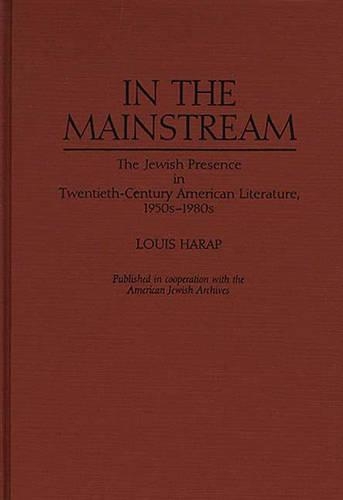
In the Mainstream: The Jewish Presence in Twentieth-Century American Literature, 1950s-1980s
(Hardback)
Publishing Details
In the Mainstream: The Jewish Presence in Twentieth-Century American Literature, 1950s-1980s
By (Author) Louis Harap
Bloomsbury Publishing PLC
Praeger Publishers Inc
21st April 1987
United States
Classifications
Tertiary Education
Non Fiction
810.98924
Physical Properties
Hardback
220
Description
In the Mainstream represents the second in a multi-volume study of the Jewish American as both writer and character in our nation's literature. This book focuses on the period from 1950 to the 1980s. The author provides abundant evidence that by the end of the 1950s, Jewish writers had achieved full status in the realm of American fiction. His study examines precursors and strains of influence relating to this development, with special attention to the influence occasioned by Menorah Journal, Partisan Review, and Commentary.
Reviews
As he did in the first volume of his trilogy, Creative Awakening (CH. Sep 87), social historian Harap utilizes literature as research material. Although they appeared earlier than 1950, he rightly details the integral role of three journals--Menorah Journal, Partisan Review, and Commentary as stimuli to burgeoning Jewish creativity. Delmore Schwartz and Isaac Rosenfeld are examined as precursors of the post-WWII literature of alienation. Harap continues his discussion of Jewish characters as depicted by both Jewish and non-Jewish authors, but he focuses on the outpourings of Jewish writers beginning with the 1950s, which he terms the Jewish Decade.' Reasons for Jewish entry into the mainstream range from a more open awareness of anti-Semitism, as portrayed in works such as Laura Z. Hobston's media-successful Gentleman's Agreement (1947), to public interest in Jews triggered by the revelation of the Holocaust and the ensuing reestablishment of the state of Israel. Whole chapters are devoted to critical analyses of Saul Bellow, Bernard Malamud, Philip Roth, and Norman Mailer. The last section examines religiously committed newer writers, such as Chaim Potok, Arthur Cohen, and Cynthia Ozick.-Choice
"As he did in the first volume of his trilogy, Creative Awakening (CH. Sep 87), social historian Harap utilizes literature as research material. Although they appeared earlier than 1950, he rightly details the integral role of three journals--Menorah Journal, Partisan Review, and Commentary as stimuli to burgeoning Jewish creativity. Delmore Schwartz and Isaac Rosenfeld are examined as precursors of the post-WWII literature of alienation. Harap continues his discussion of Jewish characters as depicted by both Jewish and non-Jewish authors, but he focuses on the outpourings of Jewish writers beginning with the 1950s, which he terms the Jewish Decade.' Reasons for Jewish entry into the mainstream range from a more open awareness of anti-Semitism, as portrayed in works such as Laura Z. Hobston's media-successful Gentleman's Agreement (1947), to public interest in Jews triggered by the revelation of the Holocaust and the ensuing reestablishment of the state of Israel. Whole chapters are devoted to critical analyses of Saul Bellow, Bernard Malamud, Philip Roth, and Norman Mailer. The last section examines religiously committed newer writers, such as Chaim Potok, Arthur Cohen, and Cynthia Ozick."-Choice
Author Bio
LOUIS HARAP, former editor of Jewish Life, is currently on the editorial board of Jewish Currents.
